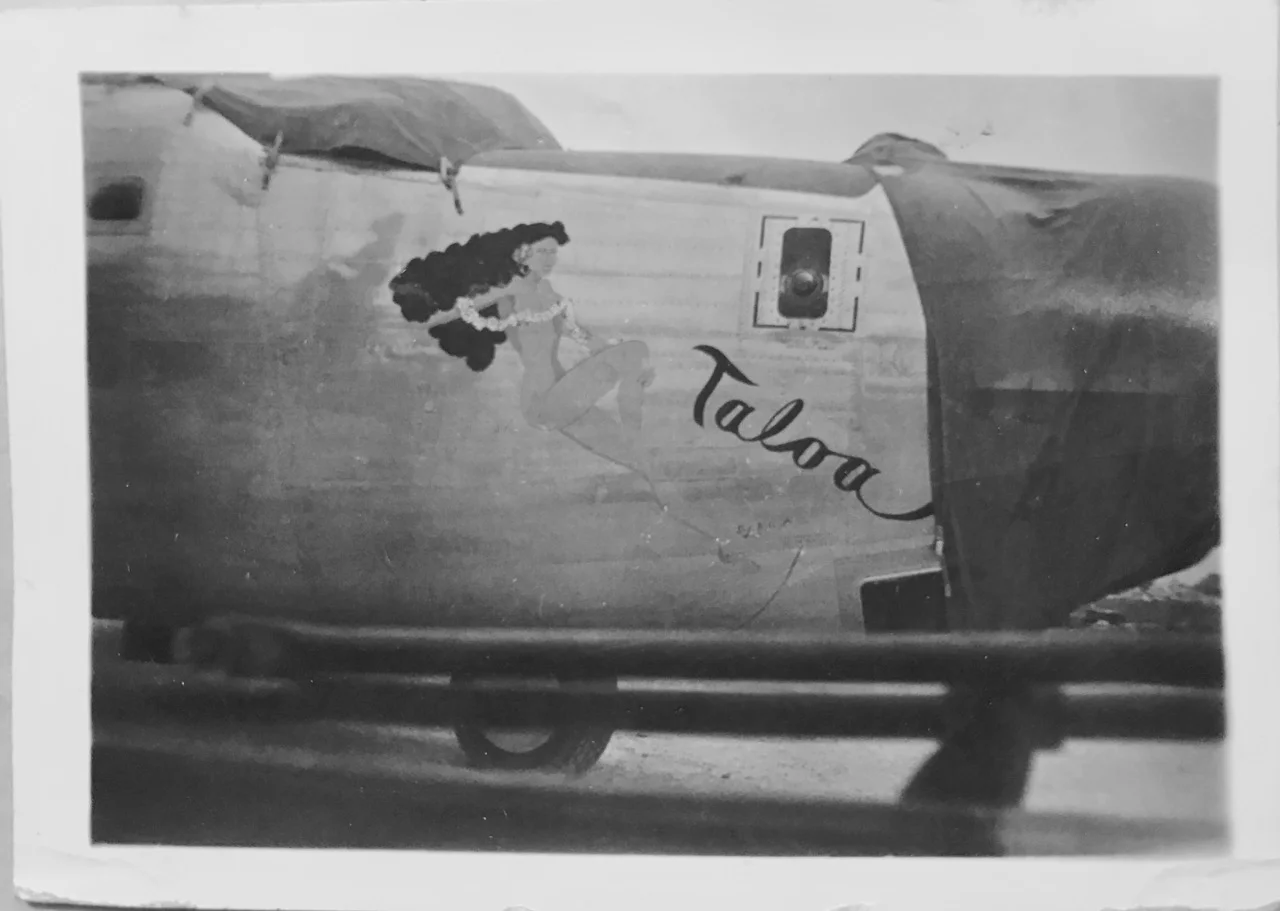The Taloa and Her Crew
B-24J S/N #44-40716, 7th U.S. Army Air Force, 494th Bombardment Group, 866th Bomber Squadron
On the 28 July mission to bomb the Japanese Battleship Haruna, the Taloa was flown by one of the original flight crews of the 494th Bombardment Group, Joseph Dubinsky's Crew #49. Joe Dubinsky's crew survived many long and dangerous combat missions over the Philippines and other islands, flying the B-24J 'Til Then from Angaur, Palau. Dubinsky had become a close friend to the 866th Squadron leader, Emil Turek.
Taloa crew. In this undated photo, Joe Dubinsky's crew of the Taloa on 28 July, 1945, poses in front of the partially visible "nose art" of the Lonesome Lady.
Top row from left: 1st Lt. Joseph Dubinsky (Pilot), 1st Lt. Rudolph Flanagin (Co-pilot), 1st Lt. Robert C. Johnston (Bombardier), 1st Lt. Lawrence Falls (Navigator), T/Sgt. Walter Piskor
Bottom row from left, T/Sgt. David Bushfield, S/Sgt. Camillous Kirkpatrick, S/Sgt. Charles Baumgartner, S/Sgt. Charles Allison. Not shown are S/Sgt Julius Molnar (Tail Gunner) and observer Captain Donald F. Marvin. Photo: Courtesy of Mr. David H. Rogers.
The nose art of the Taloa. She is said to be named after a pilot's girlfriend in Panama. She completed 44 combat missions.
Missions from Yontan, Okinawa
Lt. Turek was Dubinsky's Squadron Leader, flying Lonesome Lady on their first combat mission from Okinawa on 5 July, 1945. It was Turek's 30th combat mission, and the first B-24 raid from Okinawa on the main islands of Japan. The 494th Bombardment Group had arrived in strength less than 24 hours earlier at the captured Yontan Airfield at Yomitan, Okinawa. The men knew something of the months-long battle to take the island in the 7th Army Air Force’s campaign to attack homeland Japan from the air. Fighting continued on Okinawa, and they were yet to feel the full force of desperate Japanese kamikaze and parachute attacks. They were proud to have launched 48 planes in just 48 minutes. Turek was concerned when Dubinsky, flying the unnamed B-24 S/N #980, aborted that mission due to a mechanical problem. After the mission, Turek recorded the his friend’s safe return simply by marking Dubinsky’s name out on his Formation Sheet.
The original crew that was assigned to Taloa was Donald Marvin's Crew, #46. However, for the desperate mission on 28 July, 1945, Marvin boarded with Dubinsky’s crew on the Taloa.
A long-told back-story is that Don Marvin was unassigned but flew the desperate mission so that he would complete 40 combat missions. It was an honorable but fateful and unfortunate decision, since none of the men aboard Taloa returned from the mission. The 494th’s Group History tells the story that although Marvin missed one of his crew’s previous missions due to an injury while officiating a volleyball game back on Palau, Marvin knew that he was not required to fly another combat mission and was cleared to return stateside for furlough or reassignment with the rest of his crew. This widely told story that explains why Marvin was aboard Taloa conflicts with an account provided by Dubinsky’s (half-)brother, Branko Stupar to 494th Bombardment Group historian, Dave Rogers. Stupar was a 21-year-old US Navy Officer at Okinawa in charge of a landing craft that was carrying fuel and bombs on shore. Stupar was given permission to fly on Taloa as an observer. According to Stupar, he showed up to the briefing for the Haruna mission, but was bumped off by Marvin. A flight surgeon asked Marvin to fly as a relief pilot to Dubinsky, because Dubinsky had been diagnosed with a heart defect. There is some circumstantial evidence to support this account: 866th Formation Sheets that document August missions show that Marvin’s crew did, in fact, fly several subsequent combat missions with Co-pilot Lowell Green. The Missing Air Crew Report that was filed for Taloa records Marvin’s role as “Observer”. That may have been a designation carried over from Stupar’s previously assigned role that day, or perhaps it indicated that Marvin was observing Dubinsky.

